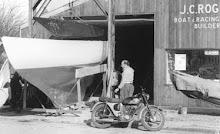
Recently we have been dropping down to the yard en masse to check on the progress of Calypso. I'm not sure whether our children are especially wild or whether it's normal for boys but they seem to explode out of the car and disperse like a gas into all corners of the yard, causing all sorts of trouble. The twins are only four, so I don't expect them to really grasp what is going in terms of "building our own boat" but I am hopeful that the bigger boys will learn a lot from the process. The concept of the inside-out boat has been quite hard to grasp, one day we spent a few minutes discussing this and although Inigo, our seven year old, was concentrating really hard, it clearly wasn't getting through. Suddenly I came up with a great way of explaining it. "Ini, you remember last year you made those chocolate Easter eggs using a plastic mould"? - Inigo's face lights up, and that's it, the boat has gone, his brain is entirely full of chocolate. "How many days is it til Easter Mummy"? Suddenly I find myself calculating how many days til Easter, one of the twins falls over, and the moment is lost! Maybe next week I'll think of a better example, not involving chocolate.









